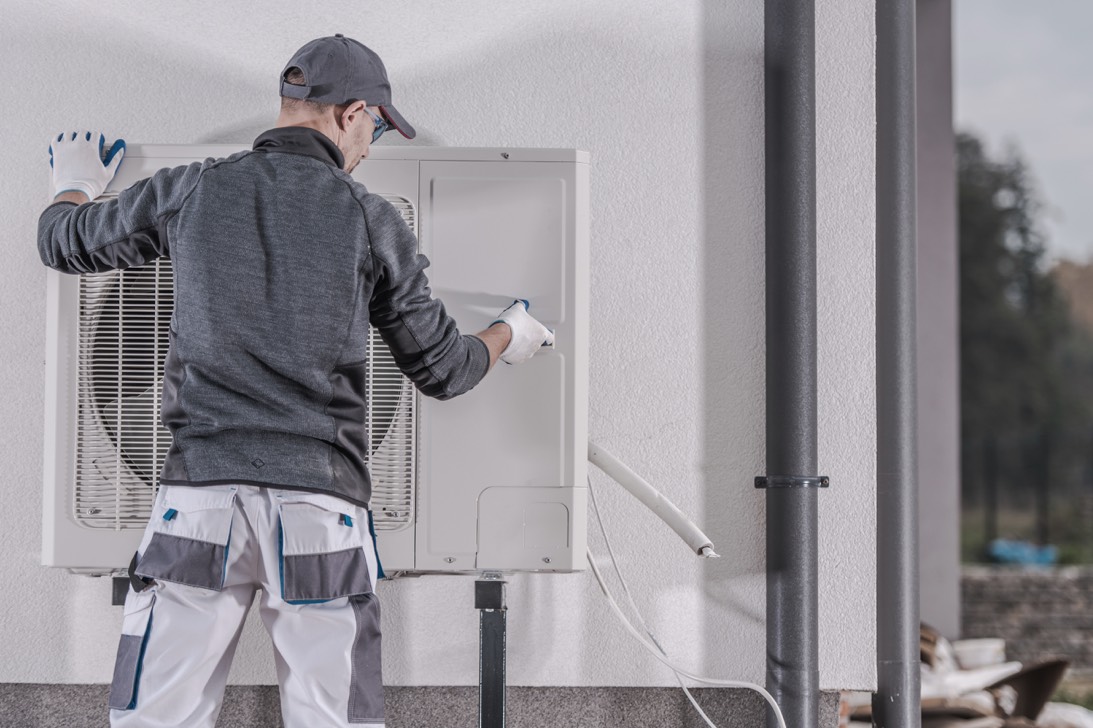You will need about 2M (6.5ft) by 1M (3ft) of outside space for a typical monobloc air source heat pump. An air to water heat pump will require a cylinder inside your home. These are typical heat pump dimensions. You will need more space inside for a split system.
We have summarised the amount of space you’ll likely to need in the table below. Read on to get more detailed information about heat pump dimensions.
| System | Unit | Typical Dimensions (4 bed home) |
| Air to water (monobloc) | Outside unit | 1.5M x 1M |
| Air to water (monobloc) | Water cylinder | 1.3M x 0.5M |
| Air to water (split) | Outside unit | 1.5M x 1M |
| Air to water (split) | Water cylinder | 1.3M x 0.5M |
| Air to water (split) | Indoor unit | 0.7M x 0.5M |
What is a heat pump?
A heat pump takes ambient heat from outside your home and then distributes it inside. An air source heat pump takes the heat from the air outside your home. A ground source heat pump takes it from the ground.
Heat pumps use a liquid refrigerant to absorb the heat outside your home. The system then compresses the liquid further to make it hotter. Once the system displaces the heat inside your home, it pumps the liquid outside and the whole process starts again.
Air source heat pumps are by far the most common type of heat pump in the UK. They are much cheaper to install and do not require a large outside space.
Air to air vs air to water heat pumps
Heat pumps come in two main flavours, air to air and air to water. An air to air system (HVAC systems) is like an air conditioner in reverse. It heats your home by blowing warm air into it, either via a system of ducts, or directly from an internal unit.
These types of system are much more common in the USA, where houses are designed to use forced air heating systems. Generally speaking, an air to air system is much cheaper to install. It will not heat your hot water but it can generally provide air conditioning for cooling needs in the summer.
An air to water system uses the heat gathered from outside your home to heat water inside. You can then use this water to heat your home via radiators or underfloor heating and for other domestic purposes such as showers or cooking. These types of heat pump are much more common in the UK. They are a much closer replacement for a traditional gas boiler.
Monobloc vs split-system heat pumps
Another important distinction to make when talking about heat pump dimensions is the difference between monobloc and split-system heat pumps.
In a monobloc system all the components, including the compressor, condenser and evaporator are housed in a single outdoor unit. In an air to air system, the indoor unit is a simple air handler. With an air to water heat pump system, the heated water is pumped through to a storage cylinder inside the property.
Split system heat pumps consist of separate indoor and outdoor units connected by refrigerant lines. The outdoor unit contains the compressor and condenser. In an air to air system the indoor unit handles the heat exchange with the inside air. In an air to water system the indoor unit will heat the water from the refrigerant.
How much space do I need for an air-source heat pump?
Air source heat pumps are by far the preferred choice in the UK, they do not require much of a garden and they do not require any ground excavation.
The heat pump dimensions and the amount of space you will need will depend on several factors:
Split system or monobloc
A monobloc system will require less space. This makes them the most popular choice in the UK where space is limited. A split system heat pump has a larger footprint.
The power required for your heat pump
Heat pumps come in different sizes. The power of the heat pump will determine the heating capacity. We’ve written about this elsewhere on the site. In the UK we give the power of a heat pump in KW. The right heat pump for your project will depend on the size of the home (its square footage) as well as the local climate and your household.
Proper heat pump sizing is complicated. You should always consult a qualified HVAC expert, but there are some rules of thumb. For a recent new build, or renovation the requirement is around 30-50 Watts per m2 of floor space. Thus a 165m2 house might require a 7.5KW unit.
In North America, the power of a heat pump is normally given in Tons. One ton is the equivalent to 12,000 British Thermal Units, or 3.5KW. Our typical 7.5KW heat pump is the equivalent of a 2-ton system in the USA. Homes do tend to be bigger in North America and a larger home may require a 3-ton heat pump or a 4-ton system.
How much outside space do you need for an air source heat pump?
A typical outside unit is somewhere between 1m-1.5m high and 0.5m-1m wide. As you might expect, if you go for a more powerful system, the outdoor unit maybe larger.
On top of the heat pump size you will need to ensure that you have enough air flow around it. This is extremely important as the unit draws in air from the front and the back for efficient heating.
We would say that a 2m x 1m space in your garden should be enough for most outside units.
Where should I put the outdoor unit of my air source heat pump?
You should always locate your heat pump on a flat surface. They are normally quite heavy units, and tend to produce a lot of vibration. So they do need to be sitting on something sturdy. It’s also best to have them next to a flat wall of your house and avoid the corners, as the air flow is better here.
It’s possible to have the outside unit located far away from the house, but this is not always the best idea. The water (in a monobloc system) or the refrigerant (in a split system) runs from the outdoor unit into the home. The longer the pipe run, the more heat it will lose along the way, and the more inefficient the system will be. This could raise your heating costs, especially if you live in a cold climate.
Although a well installed heat pump is not normally too noisy, we would advise against putting it right underneath a window.
How much indoor space do you need for an air-source heat pump?
This really does depend on whether you’re installing a monobloc or split system. A split system will have more indoor components.
Indoor space required in a monobloc installation
In a monobloc heat pump installation (air to water) you will just need an indoor water cylinder.
Again the size of the water cylinder required will depend on the size of your home and your household. A 4 bedroom home with 2 bathrooms will need a water cylinder of between 200 and 300 litres. This will be something like 1.3M high by 0.5M wide. Again the cylinder will need space around it for access, pipework etc.
If your house has a traditional gas boiler you may already have a water cylinder inside. Your HVAC engineer will be able to advise you on whether you can use your existing cylinder with your new air source heat pump. However, many houses in the UK are fitted with combi gas boilers. These boilers produce hot water on demand and do not work with storage cylinders. If you have a combi boiler and you wish to install an air source heat pump you will need to think about where your cylinder will go.
Indoor space required in a split system
With a split system, some of the heat exchange is done inside your home. This is between the refrigerant fluid and the water (in an air to water system) or air (in an air to air system).
Different manufacturers will vary, but indoor units in an air to water split system are roughly the same size as a combi boiler typically around 70cm x 50cm x 30cm. If you already have a combi boiler you may well be able to replace it for your indoor unit.
If you are installing an air to water system you will need to think about where you put your cylinder however – same as a monobloc installation.
For an air to air system, it will depend on whether you’ve chosen a ducted or a ductless system. A ducted system uses a central air handler, which dispenses the hot air in your home via a network of ducts. A ductless (or mini split) is essentially a series of individual units. We advise you to read further on this as it can get quite specialised.
How much space do I need for a ground source heat pump?
As a ground source heat pump (sometimes called a geothermal heat pump) takes heat from the ground outside your home, you will need to have at least some garden space to install one. There are two types of ground source heat pump, horizontal and vertical systems.
With a horizontal system, the installer arranges the pipes in a horizontal array at a much shallower depth. Typically you will need around 700m2 of garden space to install a horizontal system.
With a vertical system, the installer places the pipes into a deep bore hole. Vertical systems require less outside space, but they are much more expensive to install. Typically you would only need around 11m2 of garden space.
You will also need space for the heat pump unit which contains the compressor etc. It’s a similar size to the outside unit for an air source heat pump and can be housed in a plant room outside, a garage or in a utility room in the house.
Do I need planning permission to install a heat pump?
In the UK Typically no. The local authority will normally consider your heat pump installation (air source or ground source) as permitted development. This means you will not need to apply for formal planning permission.
There are limits on this however. There are strict rules about how big and noisy the outside unit is allowed to be as well as the distance from your house. If you live in a conservation area or an area under Article 4 (where permitted development rights have been curtailed), you may need to apply for full planning. Always consult a planning expert before you go ahead and install the system.
Heat pump dimensions in summary
We hope that this article has given you some idea of the dimensions of a heat pump, and how much space you will likely need. With heat pump installation, the most important factor is to first understand what the right size heat pump is for your property. An oversized system can cause as many problems as an undersized system so it’s very important to get this right. Heat pump installers generally work with a wide selection of heat pumps, and should be able to advise you as to the correct system for your home.
Timely registration of your new equipment is also important and will ensure that your equipment lasts as long as possible and provides year-round comfort.
For more information on the cost of a heat pump installation please check out our article “how much does a heat pump cost”.

